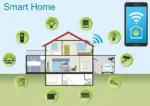Have you ever wondered where your energy bill actually goes? You may consume, on average, the same amount each month (give or take), but have you ever wondered how your energy consumption breaks down? It’s an important detail to know if you are going to effectively cut back on your energy costs by conserving energy. It’s also an important detail to know if you are going to invest in the right smart home energy technology to help your home consume energy more cost efficiently.
How can smart home energy technology help?
Nowadays, there isn’t much you can’t do with your smartphone. With smart home energy technology, you can even set up your phone to control your energy consumption in certain areas of your home to help you use your energy more conveniently and efficiently. Did you forget to turn the lights off when you left? You can turn them off with your phone or computer. Do you want to keep the heat turned down while still being able to come home to a warm and cozy home in the winter—or a cool and comfortable home in the summer? You can use your smart phone to turn your heat up or turn up your central cooling when you are on your way home from work. Not into the smartphone craze? You can use smart home technology to set timers instead.
Here’s how your energy bill breaks down—and how smart home technology can help
The average household spends approximately $2,000 a year on energy costs. While you could save on some of these costs by making some changes in your home, with smart home energy technology, you could trim those costs by as much as a third by simply targeting these key areas:
- Heating and Cooling
- Lighting
- Appliances
Heating and Cooling
Heating and cooling accounts for almost half (45%) of the average energy bill. This may seem like an unavoidable expense, but there is a smart home energy technology solution: a programmable thermostat (also called a smart thermostat). By installing a programmable thermostat, you give yourself the power to control the climate of your home at any time of the day. For instance, program the thermostat to lower your heat when you aren’t home, like during the workday, and to raise the heat for when you usually get home. You can modify the settings for seasons, weekdays vs. weekends, etc. Some programmable thermostats will even allow you to sync to your smartphone so you can make adjustments remotely throughout the day. How much can you actually save? As much as $150 a year.
Lighting
On average, 25 per cent of your energy bill goes to your lighting. There are a few smart home energy technology solutions, though. Apart from simply turning off the lights when you aren’t using them, you can install automatic timers and motion detectors to help ensure that the lights are only on when they need to be. You can also install dimmers on your lights to reduce the wattage your lights output, and you can easily reduce the wattage further by switching to energy efficient lightbulbs. Most provincial governments have an incentive in place to help you cover the costs of making this simple switch. Is there a smartphone solution, too? Absolutely. You can install a Wi-Fi enabled light switch that will allow you to control your lights from anywhere in the world.
Appliances
Approximately 9 per cent of your energy bill goes to running your appliances, and an additional 8 per cent is dedicated to just your fridge. You can lessen the impact of that 17 per cent by switching to energy efficient appliances. Can you make your appliances more efficient with smart home energy technology? Of course! Devices like the Wi-Fi enabled smart plug can help you control any appliance from anywhere as well as monitor how much energy it uses.












